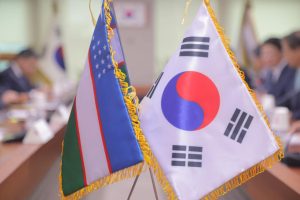This week, Uzbek Minister of Employment and Poverty Reduction Behzod Musaev was in Seoul for a series of meetings that underscored a deepening of labor relations between the two countries. Bahzod met with his counterpart, Korean Minister of Labor and Employment Lee Jung-sik, on May 7. On Telegram, the Uzbek ministry noted a planned expansion of sectors in which Uzbek citizens will be eligible for work.
Uzbekistan is among the 16 countries eligible for South Korea’s E-9 “Non-Professional Employment” visa. In April, the South Korea government started accepting applications from business owners operating in the restaurant, hospitality, forestry, and mining sectors to hire foreign workers under the E-9 scheme. As the Korean Herald noted, “Previously, E-9 visa holders could only work in the agriculture, fisheries, manufacturing, and construction sectors.”
E-9 visas can be issued to citizens of Bangladesh, Cambodia, China, Indonesia, Kyrgyzstan, Laos, Mongolia, Myanmar, Nepal, Pakistan, the Philippines, Sri Lanka, Thailand, Timor-Leste, Uzbekistan, and Vietnam.
The total number of visas issued under the program has grown considerably since President Yoon Suk-yeol took office. In 2023, the South Korean government capped E-9 visas at 110,000 – the largest quota since the visa’s introduction in 2004. In previous years it was generally in the 50,000-60,000 range. In the latter part of 2023, media reports suggested that the quota would jump to 165,000 for 2024, along with the expansion of eligible businesses.
There are also other visa categories that Uzbeks may be eligible for, such as the E-7 “Foreign National of Special Ability” visa.
Musaev also met with the chairman of the Automotive Industry Association of the Republic of Korea Kwak Young-cheol, who said the industry needs around 3,000 additional workers annually (these appear to be E-7 skilled worker positions). Although no specific agreement was announced, the Uzbek ministry stated in its Telegram channel: “The Koreans said that there is a demand for 3,000 more workers per year in this industry, and they want to cooperate with Uzbekistan in this regard.”
Earlier this year, Uzbek media reported that Tashkent “plans to send 100,000 Uzbek citizens to work in South Korea,” linking to a Telegram post on the Minister of Employment and Poverty Reduction’s channel that actually states that 100,000 Uzbek citizens will be able to enter competitive processes for E-9 visa jobs, specifically in the areas of agriculture, hospitality, and construction.
On February 16, the ministry’s Agency for External Labor Migration put out a notice urging Uzbek citizens staying illegally in South Korea to leave before February 29, saying those who voluntarily departed, following the appropriate procedure, would not be deported and would retain eligibility to return to South Korea. It’s unclear how many took advantage of that opening.
South Korea has one of the world’s lowest total fertility rates at 0.9 births per woman and a quickly aging population. According to the United Nations Population Fund, in 2024 19 percent of the South Korea population is over the age of 65. Only 8 percent of Uzbekistan’s population is. Uzbekistan also has a strong fertility rate of 2.7 per woman, and a large younger population. The 10-24 age category makes up 24 percent of the Uzbek population; in South Korea only 14 percent of the population is in the 10-24 age category.
According to one analysis, focused on migrant worker status and well-being in South Korea, “As of October 2023, approximately 2.49 million migrants… were estimated to reside in South Korea, which is a large and steady increase from the number of approximately 1.45 million in 2012.” The analysis went on to note:
The main industry sectors for the migrant workers included mining/manufacturing (43.9%), wholesale/accommodation/food services (18.7%), business/personal and public services (16.7%), construction (12.2%), and agriculture/fishery (5.4%), and the nationalities included China (33.3%), Vietnam (17.2%), Nepal (4.4), Uzbekistan (4.0%), and Cambodia (4.0%).
There is more to labor migration than merely matching one side’s deficits to another’s surpluses. Uzbek citizens have to compete against other pools of migrant workers, some with more established networks in the country. That said, it’s not like there is no history whatsoever between South Korea and Uzbekistan. (And I know from direct experience that there are several Uzbek restaurants in Seoul; the best in my opinion is near the city’s only mosque in iconic Itaewon).
Language, in particular, poses a barrier for Uzbeks aiming for skilled or semi-skilled work in South Korea. That said, there are efforts underway to address this issue, for example via government-run King Sejong Institutes, which aim to teach Korean language and culture abroad. There are seven such institutes in Uzbekistan, the most in any Central Asian state (Kyrgyzstan comes in second with five).
In September 2023, South Korean President Yoon and Uzbek President Shavkat Mirziyoyev met on the sidelines of the U.N. General Assembly. At the time, Mirziyoyev invited Yoon to make a state visit. Yoon’s predecessor, Moon Jae-in, visited Central Asia – stopping in Turkmenistan, Uzbekistan, and Kazakhstan – in April 2019.
It appears that a visit is in the works. One Korean report on Musaev’s meeting with automotive industry figures quoted the Uzbek minister as saying that Yoon would travel to Uzbekistan in June. Musaev told his South Korean interlocutors that the issue of foreign workers would surely be on the agenda.

































